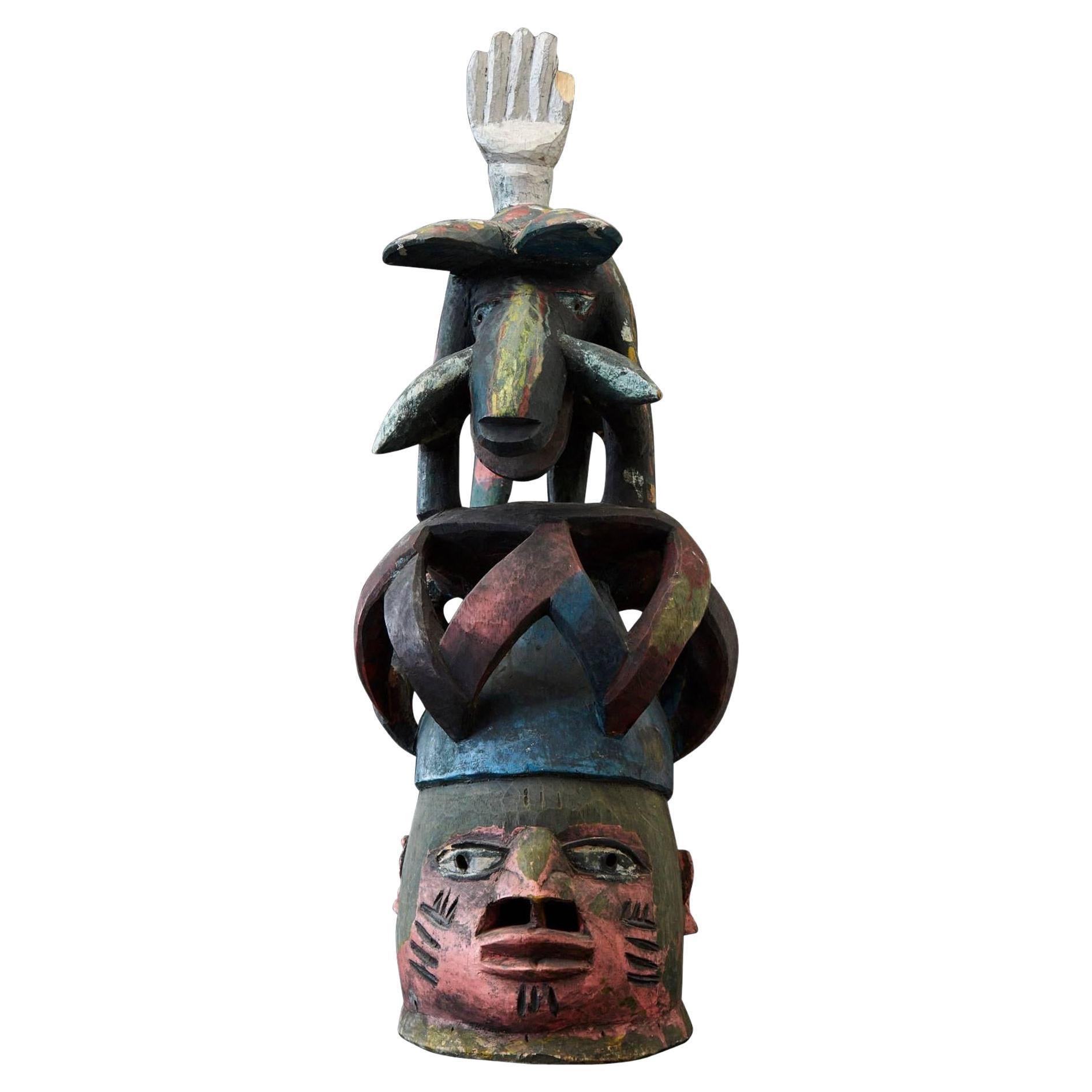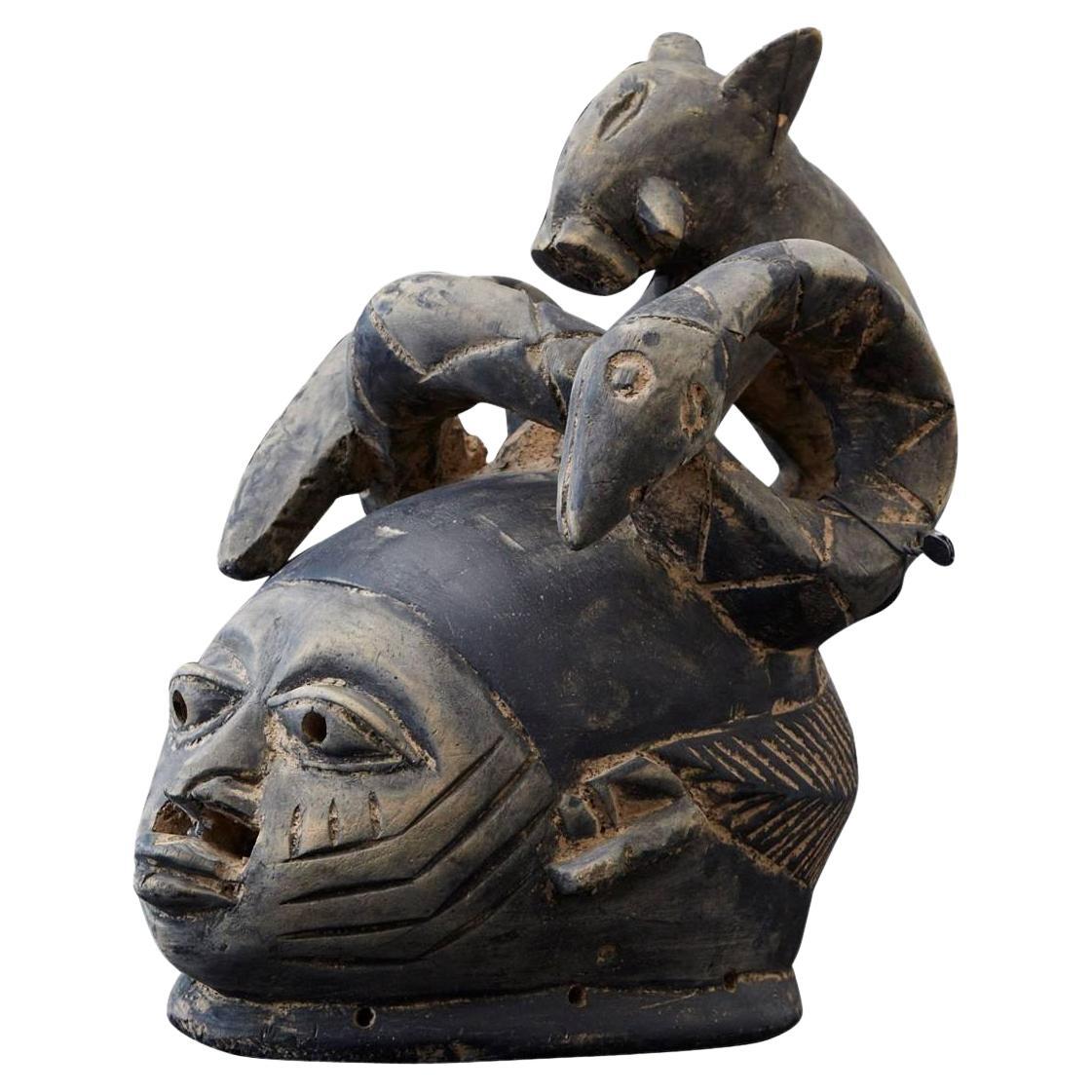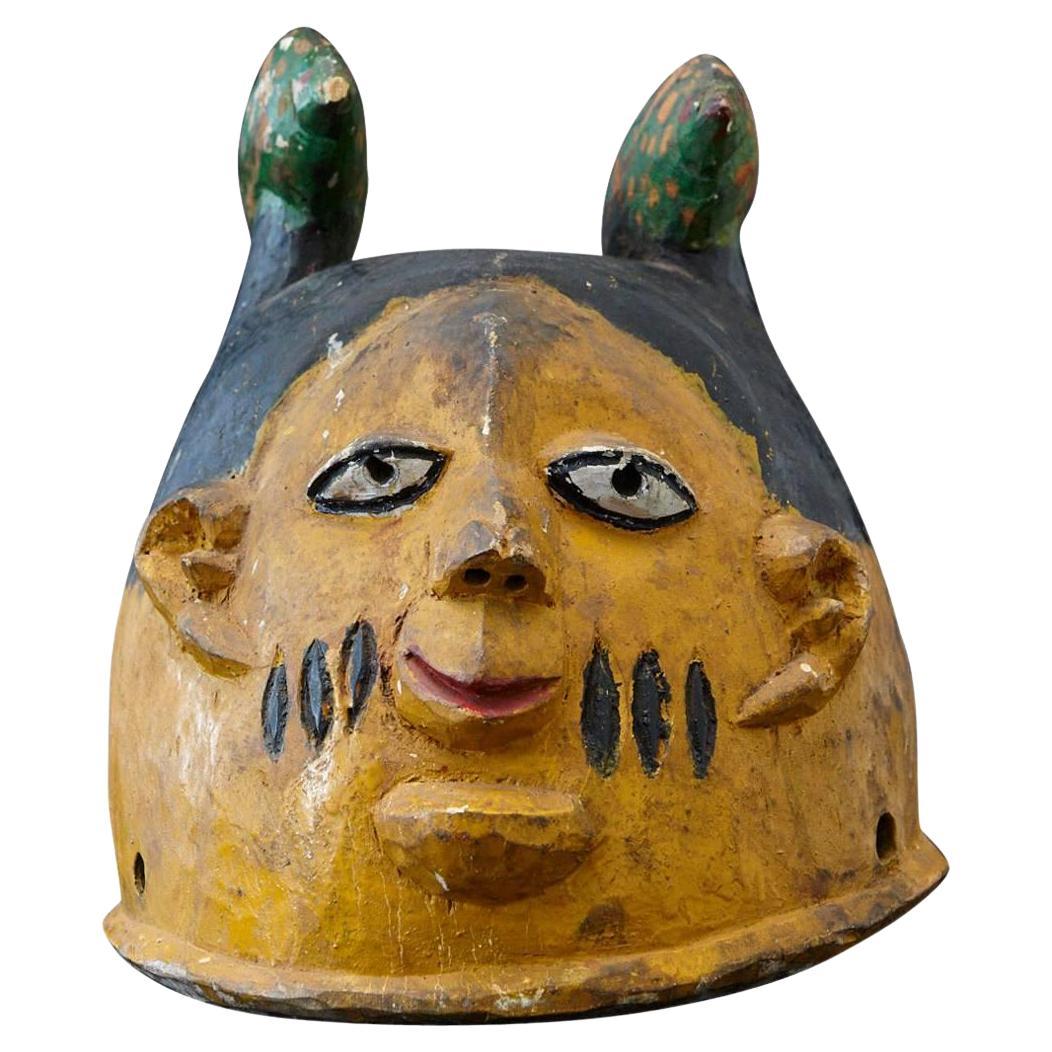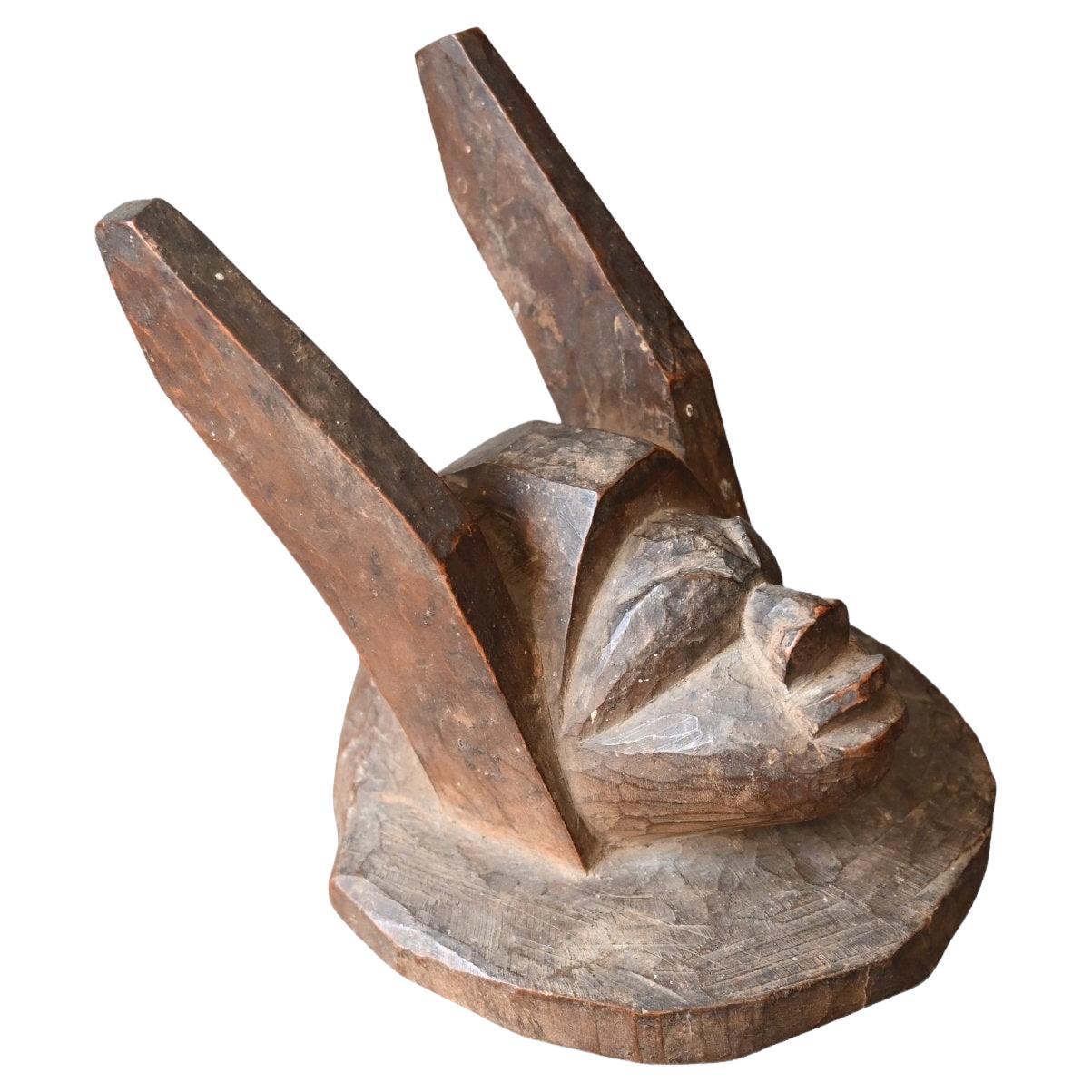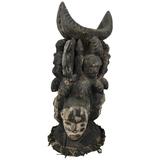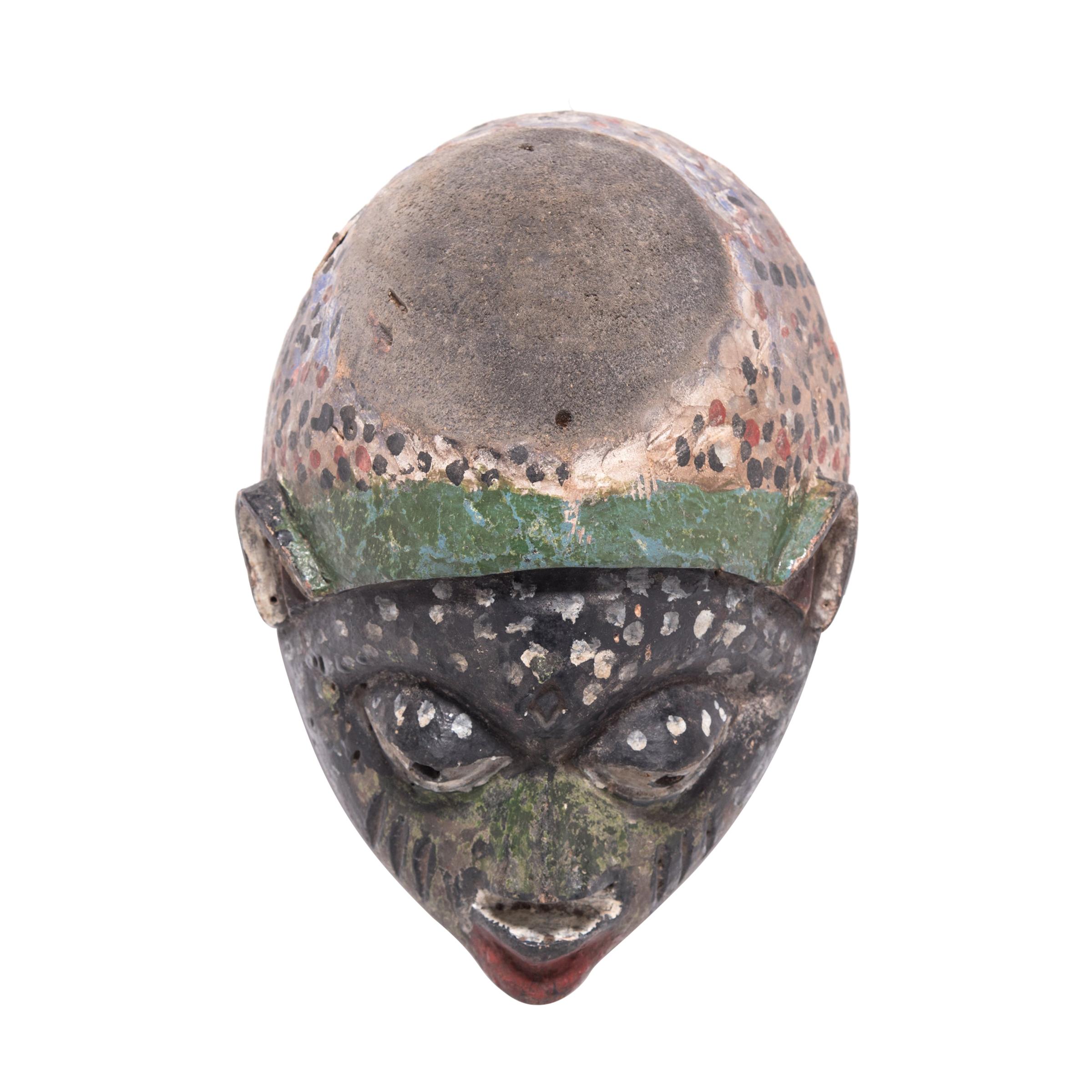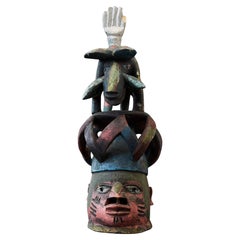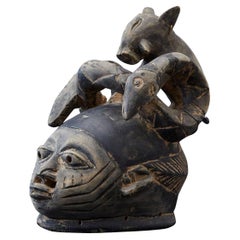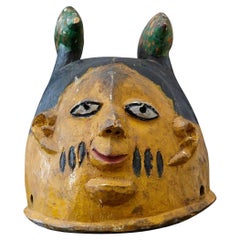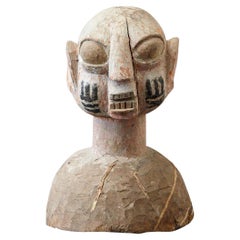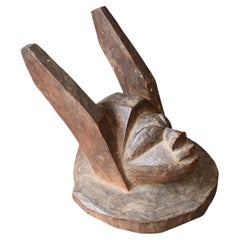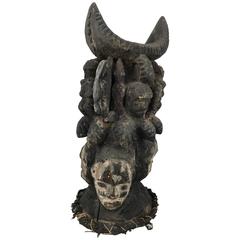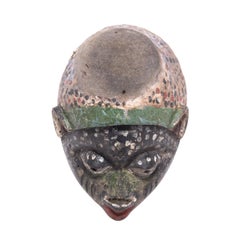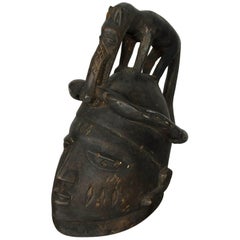Items Similar to Gelede Headdress, Yoruba People, Nigeria, circa 1950s
Want more images or videos?
Request additional images or videos from the seller
1 of 15
Gelede Headdress, Yoruba People, Nigeria, circa 1950s
$5,789.12
£4,339.30
€4,900
CA$7,953.26
A$8,879.07
CHF 4,652.50
MX$108,688.54
NOK 59,086.79
SEK 55,711.34
DKK 37,300.59
About the Item
Gelede festivals honor the creative and dangerous power of women elders, female ancestors and goddesses known as "our mothers". The Gelede headdress often consists of two parts, a lower mask and an upper elaborate superstructure. The lower mask depicts a woman's face, it's composure expressing the qualities of calmness and patience.
The static expression and simplicity of this part of the headdress contrasts with vitality and diversity of the superstructure.
The design of the superstructure is intended to placate the mothers by displaying their inner powers for all to see, thus pleasing them and ensuring the well-being of the community.
Gelede artists demonstrate their artistry and mastery of the medium by developing complex imagery within the confines of the basic cylindrical mass of wood. The elaborately carved examples, painted in bright colors, exhibit many different forms and angles to view, as the dancer moves before his admiring audience.
The numbers are the inventory numbers from Penn State University and Lehigh University.
Exhibited: The Pennsylvania State University - Museum of Art permanent collection; The Lehigh University - Art Galleries permanent collection.
Provenance: The collection of Dr and Mrs John E. Swanson.
Dr John Swanson and his wife Marian lived from 1966 - 1981 in Lagos, Nigeria where Dr Swanson was the Advisor to the National Universities Commission and later on the Chief Planning Officer of the University of Ibadan, Nigeria.
During their time in Africa the Swansons started to collect African art. In 1973 a part of their collection, circa 120 pieces went on loan to The Pennsylvania State University Museum of Art, where the remained until 1978.
In 1981 Dr Swanson passed away and his wife Marian never returned to Africa.
In 1982 Mrs Swanson lent 130 pieces to the Lehigh University Art Gallery where they remained until 1987. A few pieces were also lent to Lafayette College - Williams Art Center for an exhibition titled "Plainly Geometric - Selections of Art from West Africa". In 2018 Mrs Swanson passed away.
- Creator:Yoruba People (Artist)
- Dimensions:Height: 20.75 in (52.71 cm)Width: 9.25 in (23.5 cm)Depth: 15 in (38.1 cm)
- Style:Tribal (Of the Period)
- Materials and Techniques:
- Place of Origin:
- Period:
- Date of Manufacture:circa 1950s
- Condition:Wear consistent with age and use.
- Seller Location:Aramits, FR
- Reference Number:1stDibs: LU6432227944202
About the Seller
5.0
Vetted Professional Seller
Every seller passes strict standards for authenticity and reliability
Established in 2008
1stDibs seller since 2022
27 sales on 1stDibs
Typical response time: 2 hours
- ShippingRetrieving quote...Shipping from: Aramits, France
- Return Policy
Authenticity Guarantee
In the unlikely event there’s an issue with an item’s authenticity, contact us within 1 year for a full refund. DetailsMoney-Back Guarantee
If your item is not as described, is damaged in transit, or does not arrive, contact us within 7 days for a full refund. Details24-Hour Cancellation
You have a 24-hour grace period in which to reconsider your purchase, with no questions asked.Vetted Professional Sellers
Our world-class sellers must adhere to strict standards for service and quality, maintaining the integrity of our listings.Price-Match Guarantee
If you find that a seller listed the same item for a lower price elsewhere, we’ll match it.Trusted Global Delivery
Our best-in-class carrier network provides specialized shipping options worldwide, including custom delivery.More From This Seller
View AllGelede Headdress, Yoruba People, Nigeria, circa 1950s
By Yoruba People
Located in Aramits, Nouvelle-Aquitaine
Gelede festivals honor the creative and dangerous power of women elders, female ancestors and goddesses known as "our mothers". The Gelede headdress often consists of two parts, a lo...
Category
Mid-20th Century Nigerian Tribal Tribal Art
Materials
Wood
Gelede Headdress, Yoruba People, Nigeria, circa 1920s
By Yoruba People
Located in Aramits, Nouvelle-Aquitaine
Gelede festivals honor the creative and dangerous power of women elders, female ancestors and goddesses known as "our mothers". The Gelede headdress often consists of two parts, a lo...
Category
Early 20th Century Nigerian Tribal Tribal Art
Materials
Wood
Polychrome Wood Gelede Headdress, Yoruba People, Nigeria, circa 1940s
By Yoruba People
Located in Aramits, Nouvelle-Aquitaine
Gelede festivals honour the creative and dangerous power of women elders, female ancestors and goddesses known as "our mothers". The Gelede headdress often consists of two parts, a lower mask and an upper elaborate superstructure. The lower mask depicts a woman's face, it's composure expressing the qualities of calmness and patience.
The numbers are the inventory numbers from Penn State University and Lehigh University.
Exhibited: The Pennsylvania State University - Museum of Art permanent collection; The Lehigh University - Art Galleries permanent collection.
Provenance: The collection of Dr and Mrs John E. Swanson.
Dr John Swanson and his wife Marian lived from 1966 - 1981 in Lagos, Nigeria where Dr Swanson was the Advisor to the National Universities Commission and later on the Chief Planning Officer of the University of Ibadan, Nigeria.
During their time in Africa the Swansons started to collect African art. In 1973 a part of their collection, circa 120 pieces went on loan to The Pennsylvania State University Museum of Art, where the remained until 1978.
In 1981 Dr Swanson passed away and his wife Marian never returned to Africa.
In 1982 Mrs Swanson lent 130 pieces to the Lehigh University Art Gallery where they remained until 1987. A few pieces were also lent to Lafayette College...
Category
Mid-20th Century Nigerian Tribal Tribal Art
Materials
Wood
Wooden Head of a Wife of an Ooni of Ile-Ife, Yoruba People, Nigeria, circa 1930s
By Yoruba People
Located in Aramits, Nouvelle-Aquitaine
Wooden head of a wife of an Ooni of Ile-Ife, Yoruba People, Nigeria, circa 1930s.
The Ooni is the traditional ruler of Ile-Ife. The Nigerian town is seen as the cradle of the Yoruba people.
The number is the inventory number from Lehigh University.
Exhibited: The Lehigh University - Art Galleries permanent collection.
Provenance: The collection of Dr and Mrs John E. Swanson.
Dr John Swanson and his wife Marian lived from 1966-1981 in Lagos, Nigeria where Dr Swanson was the Advisor to the National Universities Commission and later on the Chief Planning Officer of the University of Ibadan, Nigeria.
During their time in Africa the Swansons started to collect African art. In 1973 a part of their collection, circa 120 pieces went on loan to The Pennsylvania State University Museum of Art, where the remained until 1978.
In 1981 Dr Swanson passed away and his wife Marian never returned to Africa.
In 1982 Mrs Swanson lent 130 pieces to the Lehigh University Art Gallery where they remained until 1987. A few pieces were also lent to Lafayette College...
Category
Early 20th Century Nigerian Tribal Tribal Art
Materials
Wood
Wooden Head of an Ooni of Ile-Ife, Yoruba People, Nigeria, circa 1930s
By Yoruba People
Located in Aramits, Nouvelle-Aquitaine
Wooden head of an Ooni of Ile-Ife, Yoruba People, Nigeria, circa 1930s.
The Ooni is the traditional ruler of Ile-Ife. The Nigerian town is seen as the cradle of the Yoruba people.
The number is the inventory number from Lehigh University.
Exhibited: The Lehigh University - Art Galleries permanent collection.
Provenance: The collection of Dr and Mrs John E. Swanson.
Dr John Swanson and his wife Marian lived from 1966 - 1981 in Lagos, Nigeria where Dr Swanson was the Advisor to the National Universities Commission and later on the Chief Planning Officer of the University of Ibadan, Nigeria.
During their time in Africa the Swansons started to collect African art. In 1973 a part of their collection, circa 120 pieces went on loan to The Pennsylvania State University Museum of Art, where the remained until 1978.
In 1981 Dr Swanson passed away and his wife Marian never returned to Africa.
In 1982 Mrs Swanson lent 130 pieces to the Lehigh University Art Gallery where they remained until 1987. A few pieces were also lent to Lafayette College...
Category
Early 20th Century Nigerian Tribal Tribal Art
Materials
Wood
Bronze Head of an Oba, Yoruba People, 1950s
By Yoruba People
Located in Aramits, Nouvelle-Aquitaine
A Benin bronze of an Oba. Oba means ruler in the Yoruba language.
Wearing a lattice-pattern cap with strands of beads suspended around the head.
The neck is bound with a lattice-patt...
Category
Vintage 1950s Beninese Tribal Tribal Art
Materials
Bronze
You May Also Like
Antique carved wooden headdress from the Yoruba tribe, Nigeria, 1900-1920
By Yoruba Tribe
Located in Bilzen, BE
A carved wooden headdress from the Yoruba tribe, Nigeria
Strong expression face
Early 20th century
Rich tribal aged patina
Heigth 12 cm, diameter 12 x 13 cm
Category
Early 20th Century Nigerian Tribal Tribal Art
Materials
Wood
Fine Idoma Headdress, Ungulali, Headcrest or Headdress Mask, Nigeria
Located in Buffalo, NY
A fine Idoma Headdress, ungulali, rising from a flaring conical base with holes around the rim for attachment, the first tier of three stylized faces with tapering chins, parted lips...
Category
Early 20th Century Nigerian Tribal More Furniture and Collectibles
Materials
Wood
African Yoruba Painted Gelede Headdress
Located in Chicago, IL
This painted mask was created by the Yoruba People of western Nigeria, and was worn during a tradition known as Gelede. A blend of ritual and artistic spectacle, Gelede pays homage to the women of their Community, understood to possess spiritual powers capable of the benefit or the destruction of society. The Gelede masquerade is an opportunity to honor or condemn behaviors within the Community, through dance, art, satire, and poetry. Worn by veiled dancers, Gelede masks...
Category
Mid-20th Century Nigerian Tribal Wall-mounted Sculptures
Materials
Wood
African Helmet Mask 'Gelede' from Yoruba Nigeria
Located in San Francisco, CA
Blacked wood helmet mask (Gelede), large human head surmounted by a dog eating a snake which curves around the head. No perforation for attachment to costu...
Category
20th Century Nigerian Tribal Figurative Sculptures
Materials
Wood
Helmet Crest Ngoin Mask from Cameroon Africa
Located in Atlanta, GA
This Helmet Crest mask is categorized as a “Babanki” style Ngoin mask from Northwestern provinces of Cameroon circa first half of 20th century. In part of highland area called “Camer...
Category
20th Century Cameroonian Tribal Tribal Art
Materials
Wood
Antique Congolese African Tribal Carved Hemba Helmet Mask, Suku Peoples
Located in Forney, TX
A scarce antique African tribal carved Hemba helmet mask, the Suku peoples, possibly Kwese culture, Democratic Republic of the Congo, Central Africa, early 20th century, surmounted by four-legged animal, over round face, with mouth ajar and incised jagged teeth exposed, protruding almond shaped eyes, scattered remnants of pigment, full raffia fiber fringe, mounted on wood stand.
A superb museum quality example, this remarkable tribal folk art sculpture is a wonderful way to add rustic warmth, rich historical depth, and fascinating cultural interest to any space!
Dimensions: (approx)
Overall: 26" High, 9" Wide, 10.25" Deep;
Mask only: 15" Tall;
7 lbs total
Provenance / Acquisition:
Acquired from the highly reputable auction house, Austin Auction Gallery, est.1983, Austin, Texas.
Excellent Condition:
Nicely aged distressed patina over the whole. Highly desirable wear consistent with age and indicative of use, including scattered losses, antique character marks and typical signs of aging throughout. Retaining scattered remnants of original pigment. Overall a superb museum quality example
Primitive Arts Of Africa:
Among the Suku of the southwestern part of the Democratic Republic of the Congo, masks plays crucial role in protecting boys during initiation, the vulnerable period between boyhood and manhood. The power contained in Hemba masks...
Category
Early 20th Century Congolese Tribal Tribal Art
Materials
Raffia, Wood
More Ways To Browse
Tribal HeadDresses
African Headdresses
African Dance Mask
West African Mask
John Powers
Yoruba Mask
Yoruba Headdress
Gelede Mask
Tribal Wood Panel
Sierra Leone
Antique African Wood Figures
African Tribal Currency
Mali Tribal Art
Tanzanian Wood
Polynesian Furniture
Antique African Masks
Belgian Congo
Bone African Art
